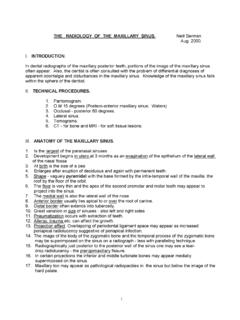Transcription of The Origin of Jonah Field, Northern Green River …
1 CHAPTER 8 The Origin of Jonah field , Northern Green River Basin, WyomingROBERT M. CLUFFThe Discovery Group Inc., Denver, Colorado, G. CLUFFThe Discovery Group Inc., Denver, Colorado, production at Jonah field and many other fields in the Green River basin is dependent on the presenceof overpressure. In the Gulf Coast and other areas, plots of shale resistivity and shale sonic transit time versus depthhave been used to identify overpressured zones. The same technique has been proposed to map overpressurecompartments and their boundaries in the Rocky Mountain region using well logs or, alternatively, intervalvelocities determined from seismic data. At Jonah field , the top of the overpressure (determined by continuousgas flaring during drilling) correlates within a few hundred feet to a drop in shale resistivity and increase in shaletransit time.
2 However, studies of nearby wildcat wells and detailed cross sections through both overpressuredand normally pressured wells show that the log anomalies extend significantly beyond the overpressured and resistivity changes in the area around Jonah tend to follow a stratigraphic boundary near the baseof the Tertiary Fort Union Formation instead of tracking the top of the overpressured studies of Jonah field considered the hydrocarbons in the field to be derived from vertical migrationof gas from regional overpressure conditions 2000 3000 ft (610 915 m) deeper. The upward migration waspresumed to be controlled by the presence of extensive microfractures that form a leakage chimney betweenlarge sealing faults. This study suggests that the log anomaly both within and surrounding Jonah provides analternative interpretation.
3 Until the middle Tertiary, overpressure conditions extended up to the base of theFort Union and resulted in undercompaction of Cretaceous shales, as reflected by resistivity and velocityanomalies. Late Tertiary relative uplift initiated slow leakage of the overpressure conditions wherever thesystem was not tightly sealed. As a result, the top of the overpressure has been dropping with time over mostof the Northern Green River basin. The sonic and resistivity anomalies are irreversible, and the logs reveal thesignature of the former overpressured and undercompacted on this new model, Jonah field represents a high remnant of the former regional top of overpressureinstead of a leakage chimney from a deeper overpressured generation cell.
4 If this model is correct, explorationmethods should focus on the seal conditions that prevent leakage instead of fracture models that Gas Accumulations andthe Sweet-spot ConceptBasin-centered gas accumulations have been a majorfocus of exploration efforts in the Rocky Mountain regionsince the mid-1980s. The concept of a basin-centeredaccumulation dates back to the work in the Elmwortharea of Alberta, where Masters (1979, 1984) describedwhat was termed a deep basin gas field in the westernCanada sedimentary basin. Subsequent work in otherRocky Mountain basins by the Geological Survey andJonah field : Case Study of a Giant Tight-Gas Fluvial Reservoir, J. W. Robinson and K. W. Shanley, eds.: AAPG Studies in Geology 52 and RockyMountain Association of Geologists 2004 Guidebook127others (McPeek, 1981; Spencer, 1983; Law, 1984; Law andDickinson, 1985) described continuous gas accumula-tions in the central parts of most basins, several of whichare not very deeply buried today.
5 Thus, the concept wasextended to include basin-centered gas as opposed tojust deep basin gas. Basin-centered gas accumulations areconsidered by many to be a worldwide phenomenoncommon to sedimentary basins throughout the Phaner-ozic (Law and Spencer, 1998).Basin-centered gas has never been tightly defined inthe literature. Most papers cite the following commoncharacteristics for a basin-centered gas accumulation ( ,Law, 2002): (1) a large, regionally pervasive gas-saturatedsection; (2) the entire interval is abnormally pressured,either overpressured or underpressured; (3) fields com-monly lack downdip gas-water contacts; (4) gas is pro-duced with minimal associated water; (5) low permeabilityof both the enclosing strata and the reservoir rocks; and(6) no obvious updip seals or trapping conditions definethe gas accumulation.
6 Because of the lack of obvious trapsor downdip free water that are characteristic of conven-tional structural and stratigraphic hydrocarbon accumu-lations, basin-centered gas has been grouped with otherunconventional or continuous hydrocarbon accumula-tions, including shale gas, coalbed methane, and gas hy-drates for resource-assessment purposes. Despite theirseemingly continuous nature over large volumes of rock,commercial production is, with few exceptions, restrictedto a small fraction of the overall observation that economic gas production tendsto be highly localized in basin-centered accumulationsled to the development of the sweet-spot concept forlow-permeability reservoirs. A sweet spot is an area ofenhanced porosity and permeability that is thought toprovide higher deliverability and, therefore, better gasrecovery than the surrounding areas (Surdam, 1997; Law,2002).
7 The Origin of the term is obscure. The first pub-lished use we know of in this context was by Sauvageau(1984) and subsequently in the geological literature byBillingsley and Reinert (1994) for the area of prolificproduction from the Almond Formation (Cretaceous,Mesaverde Group) near Wamsutter in the eastern GreenRiver spots are thought to be controlled by (1) depo-sitional trends of enhanced porosity and permeability; (2)enhanced fracturing and, consequently, higher bulkpermeability; or (3) overpressuring and improved reser-voir properties in a pressure compartment (Surdam, 1997).Examples of the first two types of sweet spot have beenextensively discussed in the literature on basin-centeredgas. The third type, an anomaly in an overpressuredcompartment, is poorly understood.
8 Because several ofthe larger basin-centered gas fields in the Rocky Moun-tain region are significantly overpressured, it has beenproposed that overpressuring is somehow causally relatedto the production of sweet spots, and they might be con-centrated near the upper boundary of the overpressuredintervals (Surdam et al., 1994, 1997; Jiao and Surdam, 1997;Surdam, 1997; Law, 2002).The idea that relief on the top of the overpressuredsurface may indicate the location of sweet spots has ledto several proposed techniques to identify and map thissurface. These include log-based techniques to identifythe top of the overpressure from sonic-log, resistivity-log, or density-log signatures (Jiao and Surdam, 1997;Surdam et al., 1997) and seismic techniques based oninversion of two-dimensional (2-D) or three-dimensional(3-D) velocity data to find reversals in the normal trendof increasing velocity with depth (Surdam et al.)
9 , 2001).This study was part of a regional project to map the topof the overpressure surface across the Northern GreenRiver basin using sonic and resistivity logs. The goal ofour work was to determine if the overpressure surfacehad a significant velocity contrast that might be detect-able with seismic data and to investigate if known loganomalies that closely coincide with the known top ofoverpressure in the Jonah Pinedale area might showsome appreciable relief outside the established field : AN OVERPRESSURED SWEET SPOTIN THE Green River BASIN?The discovery and early development history of Jonahfield was summarized by Robinson (2000). Jonah fieldwas discovered in 1986 1987 with the drilling of twowells by Home Petroleum Corporation, the Jonah Fed-eral 1-4 and 32-34, both of which encountered continuousgas shows and flared gas from about 8500 ft (2600 m) tototal depth.
10 The initial completion results of these wellswere disappointing, and the field was considered non-commercial. McMurry Oil Company rediscovered Jonahfield with the completion of the Jonah Federal 1-5 in 1993,which encountered continuous gas shows from 8429 ft(2570 m) to totaldepth of the well. Subsequent devel-opment drilling in 1994 1995 outlined a large, poorlydefined area of gas-saturated Lance Formation (UpperCretaceous), where the top of continuous gas showsbegan at or a short distance below the top of the in the overlying Fort Union Formation (Paleo-cene) had low resistivity, appeared wet on logs, yieldedonly minor or no gas shows while drilling, and weredrilled with normal mud weights. An intervening sectionof shale and shaly sandstones, tentatively correlatedRobert M.








